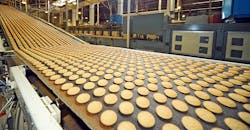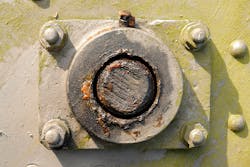6 Food-Safe Bearing Tips to Keep Your Plant Contamination Free
Many food and beverage plants rely on aging processing and packaging equipment that still uses the original-type bearings specified for the machines. Often these bearings continue to provide reliable, trouble-free service and are not a source of concern. Other times, however, older bearings go overlooked and can pose a serious risk to food safety as leaks develop and corrosion sets in.
A typical food production facility houses thousands of rolling element bearings that must be regularly inspected for grease purge, signs of rust and to ensure that mold is not taking hold in cracks and crevices. Frequent washdown and sanitation keep most equipment bearings clean, but even one assembly operating out of sight can become a breeding ground for bacteria.
For busy maintenance staff, bearings tend to take a back seat to other priorities until contamination occurs or a failed unit brings a line to a sudden halt. Unfortunately, the cost to remedy these situations often far exceeds the expense of investing in stronger bearing solutions that can avoid such troubles.
From proper inspection to understanding the many product options available to you, here are six things every plant manager should know about food-safe bearings.
1. Close Inspection is Critical
Since becoming law in 2011, the Food Safety Modernization Act (FSMA) has touched every segment of the nation’s food-safe practices including machine bearing maintenance. It wasn’t long ago that a small spot of grease or slightly corroded bearing may have escaped the attention of a plant inspector; however, failing to address these potentially hazardous scenarios can today result in stiff fines and penalties.
While most bearings do not operate in direct contact with food, they can harbor food residues or entrap foreign bodies leading to the threat of a bacterial outbreak. At the same time, the high-pressure waterjets used to wash down equipment—in combination with ultra-aggressive cleaning agents—can damage and degrade bearing seals allowing grease to escape, or can penetrate the bearing, contaminating the grease. Meanwhile, even bearings that are not subject to sanitation can start to corrode due to process moisture or when temperature fluctuations inside the plant create condensation.
A good strategy is to walk your facility with your inspection team and a trusted friction management expert to prioritize mission-critical bearings and communicate about possible issues. Oftentimes, a specialist can recommend better ways to inspect hard-to-access bearings or can anticipate where corrosion is likely to occur, having seen the problem many times before.
2. Opt for Hygienic Designed Assemblies
Food-safe bearings can look nearly identical to standard bearing products, but there are important design characteristics to be aware of. For mounted (housed) units especially, it is important that the bearing housing has a smooth and rounded profile with few ridges or crevices that could entrap food, water or debris.
Likewise, many bearings have identification numbers that are stamped into the part, but this can create raised or depressed portions of the bearing surface where bacteria can collect. For this reason, look for food-safe bearings that use laser engraving to apply part numbers and codes, which results in markings only microns deep.
Other bearings expressly designed for food and beverage plants may include features such as integral standoffs that prevent bacteria from forming between the machine frame and the back face of the bearing housing. In all cases, ask about bearings that have achieved hygienic design certification such as USDA Equipment Acceptance.
3. Use Solid Lubricants to Avoid Leaks
Ball bearings are prevalent throughout food and beverage plants, and many use a food-grade grease as a lubricant. Increasingly, however, companies prefer to eliminate the risk of leakage altogether by using bearings that use a solid lubricant to keep operations smooth.
Solid lubricants fill the bearing cavity and are permeated with oil. As the bearing operates, oil is released from the interconnected micropores of the solid polymer to lubricate the bearing. When the bearing slows and cools, the oil is again retained in the matrix through surface tension. This results in a continuous oil film between bearing contact surfaces without introducing liquid-based lubricants into the plant environment.
And by filling the bearing cavity, solid lubricants significantly lessen the chance that debris will find its way into the bearing. There is also no relubrication involved to the delight of maintenance technicians.
4. Tap into the Latest Innovation
The bearing industry is ripe with innovation including the development of optically detectable polymer materials for where bearings operate in close contact with food, particularly on conveyor belts and oven rollers. Anywhere there are machine parts there exists the potential for metal inclusions to infiltrate the production line. However, bearings having components made of blue polymers that are metal, x-ray and optically detectable can provide peace of mind that foreign material contamination is likely to be detected. Such bearings are ideal for hazard preventative programs (e.g., HACCP/HARPC) and anywhere you are looking to increase food safety levels.
5. Explore Options Beyond the Catalog
An off-the-shelf bearing solution will satisfy most requirements, but some machines, especially legacy equipment that can date back decades, demand a special fit that is not easily found in a catalog.
Ask your bearing expert about a custom solution that works for your facility. Often, bearing makers can modifying existing designs to suit new criteria with nominal investment in engineering and development. Today’s advanced computational and modeling tools allow manufacturers to design, test and speed solutions to market in a fraction of the time that was once required, making the prospect of a custom bearing solution more cost-effective than many realize.
6. Calculate the Risk to Your Operation
Costly bearing problems tend to be the result of casual oversight. Until you have experienced a setback in your own facility, it can be hard to appreciate the spending that is required to resolve such events.
Talk to a plant manager who knows the value of a stronger bearing solution, and you will find that the stronger solution can pay for itself many times over when factoring for the cost of:
- Diagnostics and determining what went wrong.
- Replacing bearings and possibly other damaged machine parts.
- Purchasing actions necessary to procure new parts.
- Premium labor rates when performing emergency repairs.
- Subsequent analysis of quality issues where the problem occurred.
- Planning and corrective actions to prevent a second incident.
- Additional supplier corrective actions and change-induced quality costs.
- Screening out of suboptimal parts and materials.
- Carrying extra inventory as a result of quality problems.
Food for Thought
Proper bearing selection can be complicated for many applications and nowhere are the stakes higher than in food and beverage plants where even one leakage or contamination event can be significant. It is advisable to audit your bearing roster every few years for improvements that will make your facility safer and more efficient. This rarely requires an overhaul of critical equipment—you are more likely to discover that a little spending can go a long way.
About the Author
The Timken Company
The Timken Company engineers, manufactures, and markets bearings, gear drives, automated lubrication systems, belts, chain, couplings and related products, and offers a spectrum of powertrain rebuild and repair services. The leading authority on tapered roller bearings, Timken today applies its deep knowledge of metallurgy, tribology and power transmission across a variety of bearings and related systems to improve the reliability and efficiency of machinery and equipment all around the world. The company's growing product and services portfolio features many strong industrial brands including Timken, Fafnir, Philadelphia Gear, Groeneveld, Drives, and Lovejoy.



